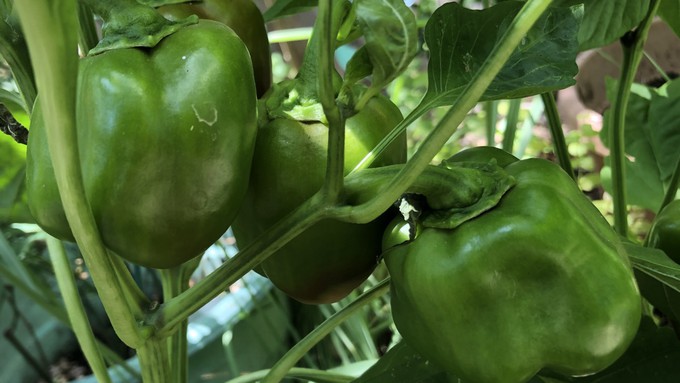
Our yo-yo weather continues; watch out for signs of plant stress

Harvesting summer vegetables such as peppers will keep the plant producing. If you wish, leave bell peppers on the plant until they turn color -- red, yellow, orange, purple or "chocolate," depending on the variety -- and then harvest them. Kathy Morrison
If you liked July, you’ll love August. This month starts out with the same spiky weather pattern: Triple-digit heat on weekends and dramatic cooldowns in between.
According to the National Weather Service, Sacramento can expect 105 degrees on Sunday. But by Tuesday, we’ll be back down in the 80s. Tuesday’s forecast high is only 89 degrees – six degrees below Sacramento’s average for the first week of August and a 16-degree drop from Sunday.
That relative cool will linger through the work week – with afternoons topping out in the high 80s or very low 90s – before creeping back up to 98 degrees next Sunday, Aug. 13.
Could the worst of our summer heat soon be behind us? Averaging highs of 91 degrees, August is typically a little cooler than July. But it’s still pretty hot. Remember to stay hydrated; that advice goes for your garden, too.
Maintaining even soil moisture – not too dry or too wet – can help plants cope with the stress of not only high heat, but yo-yo temperatures.
* Harvest tomatoes, beans, squash, pepper and eggplants to prompt plants to keep producing. Give your plants a deep watering twice a week, more if planted in containers. Most tomato plants need at least 5 gallons a week.
* Give your summer veggies a boost with phosphate-rich fertilizer to help fruiting. (Always water before feeding.)
* Cracks on your tomatoes? Blame these dramatic increases in temperature. Heat spikes likely caused those splits.
* Brown spots on the bottom of tomatoes, eggplant and peppers likely are due to blossom end rot. It’s a side effect of very dry soil. Plants need moisture so their roots can absorb nutrients and form healthy fruit.
* Watch out for caterpillars and hornworms in the vegetable garden. They can strip a plant bare in one day. Pick them off plants by hand in early morning or late afternoon.
*Feed citrus trees their last round of fertilizer for the year. This will give a boost to the fruit that's now forming.
* Mulch can be your garden's best friend; it conserves moisture while blocking out weeds. But don’t let mulch mound around stalks, stems or trunks. That can promote crown rot.
* Camellia leaves looking a little yellow? Feed them some chelated iron. That goes for azaleas and gardenias, too.
* Pinch off dead flowers from perennials and annuals to lengthen their summer bloom.
* Pick up after your fruit trees. Clean up debris and dropped fruit; this cuts down on insects and prevents the spread of brown rot. Then feed fruit trees with slow-release fertilizer for better production for next year.
* To prolong bloom into fall, feed begonias, fuchsias, annuals and container plants.
* Fertilize fall-blooming perennials, too. Chrysanthemums can be fed until the buds start to open.
* Indoors, start seedlings for fall vegetable planting, including bunching onion, cabbage, broccoli, cauliflower, kale, radicchio and lettuce.
* Sow seeds of perennials in pots for fall planting including yarrow, coneflower and salvia.
* In the garden, direct seed beets, bush beans, carrots, leaf lettuce, radishes and turnips.
* Plant potatoes.
Comments
0 comments have been posted.Sacramento Digs Gardening to your inbox.
Sites We Like
Garden Checklist for week of July 21
Your garden needs you!
* Keep your vegetable garden watered, mulched and weeded. Water before 8 a.m. to reduce the chance of fungal infection and to conserve moisture.
* Feed vegetable plants bone meal, rock phosphate or other fertilizers high in phosphate to stimulate more blooms and fruiting. (But wait until daily high temperatures drop out of the 100s.)
* Don’t let tomatoes wilt or dry out completely. Give tomatoes a deep watering two to three times a week.
* Harvest vegetables promptly to encourage plants to produce more. Squash especially tends to grow rapidly in hot weather. Keep an eye on zucchini.
* Pinch back chrysanthemums for bushy plants and more flowers in September.
* Remove spent flowers from roses, daylilies and other bloomers as they finish flowering.
* Pinch off blooms from basil so the plant will grow more leaves.
* Cut back lavender after flowering to promote a second bloom.
* It's not too late to add a splash of color. Plant petunias, snapdragons, zinnias and marigolds.
* From seed, plant corn, pumpkins, radishes, winter squash and sunflowers.